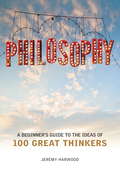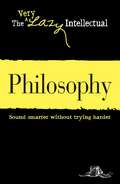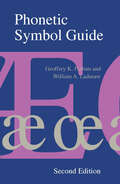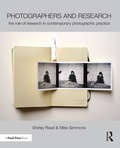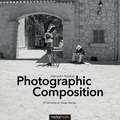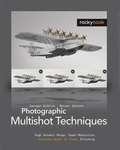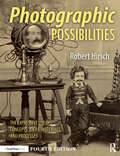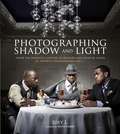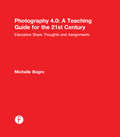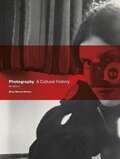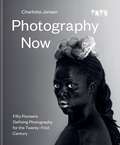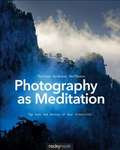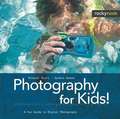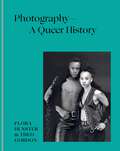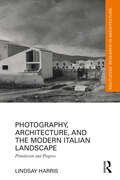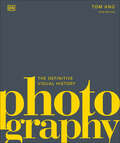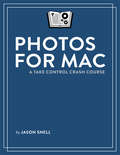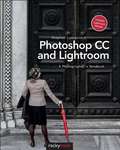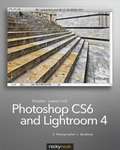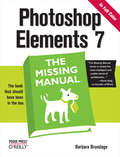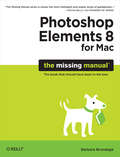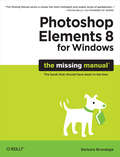- Table View
- List View
Philosophy: A Beginner's Guide to the Ideas of 100 Great Thinkers
by Jeremy HarwoodFrom philosophy's founding fathers like Thales, Socrates, and Plato to great minds of the post-modern era like Sartre, Ayer, and Feyerabend, this essential guide distills the thoughts of the world's most influential minds and explains their answers to some of philosophy's key questions. Is there a Supreme Being? Who am I? What is truth? Do we have free will? Why do bad things happen? How should we live? Is death the end of everything? What is the meaning of life?Arranged from the ancient world to the present day, each philosopher's key ideas, notable works and pronouncements are encapsulated in a series of succinct , easy-to-read biographies, accompanied by illustrations, at-a-glance fact panels and thought-provoking quotations, making this the ideal beginner's guide for those wanting to get to grips with this fascinating but often daunting subject.
Philosophy: Sound smarter without trying harder
by Adams MediaDid you sleep through Intro to Philosophy? Does Plato leave you in the dark? Fear not! The Very Lazy Intellectual: Philosophy introduces you to both the major thinkers and the fundamentals of philosophical thought. With information on everyone from Socrates to Sartre, and theories from Epicureanism to Empiricism, you’ll have everything you need to solve your existential crises in no time.
Phonetic Symbol Guide
by Geoffrey K. Pullum William A. LadusawPhonetic Symbol Guide is a comprehensive and authoritative encyclopedia of phonetic alphabet symbols, providing a complete survey of the hundreds of characters used by linguists and speech scientists to record the sounds of the world's languages. This fully revised second edition incorporates the major revisions to the International Phonetic Alphabet made in 1989 and 1993. Also covered are the American tradition of transcription stemming from the anthropological school of Franz Boas; the Bloch/Smith/Trager style of transcription; the symbols used by dialectologists of the English language; usages of specialists such as Slavicists, Indologists, Sinologists, and Africanists; and the transcription proposals found in all major textbooks of phonetics. With sixty-one new entries, an expanded glossary of phonetic terms, added symbol charts, and a full index, this book will be an indispensable reference guide for students and professionals in linguistics, phonetics, anthropology, philology, modern language study, and speech science.
Photographers and Research: The role of research in contemporary photographic practice
by Mike Simmons Shirley ReadThis ground-breaking book situates research at the heart of photographic practice, asking the key question: What does research mean for photographers? Illuminating the nature and scope of research and its practical application to photography, the book explores how research provides a critical framework to help develop awareness, extend subject knowledge, and inform the development of photographic work. The authors consider research as integral to the creative process and, through interviews with leading photographers, explore how photographers have embedded research strategies into their creative practice.
Photographic Composition
by Albrecht RisslerAll fine artists share a common goal: to combine individual elements into a convincing, cohesive whole that tells a story or expresses an intention. Photography is especially suited to this pursuit because the photographer can create multiple, distinct images of a single subject using a variety of design techniques. The display on a digital camera instantly shows the arrangement of elements in an image, allowing the photographer to make changes and refine their creation as they work.Albrecht Rissler believes that a firm understanding of image design is as important as having an observant eye or having the technical knowledge to operate a camera. Photographic Composition presents the most important concepts of image design and offers 250 beautiful photographs to illustrate these concepts. By applying these concepts to your own work, you will greatly improve your photographic eye and your ability to compose an ideal image.This book's impressive images are in black-and-white, intentionally removing the distraction of color and making it easy to focus on compositional elements and form. With this book, photographers as well as all visual artists will learn how to infuse their own images with excitement, develop and hone their visual language, and express their personal artistic aesthetic.Topics include:The effect of various aspect ratiosPerspective and compositionForm and contrastProportion and harmonySymmetry and asymmetryBrightness and darknessStructures and texturesThe "perfect moment"
Photographic Multishot Techniques
by Juergen Gulbins Rainer GulbinsPhotographers are just beginning to realize the potential of high dynamic range imaging (HDRI). Now, the newest techniques based on a bracketed series of exposures make it possible to go beyond HDRI: photographers can increase resolution for ultra-sharp, detailed images, and they can extend the depth of field in a way that was never before possible. Photographic Multishot Techniques provides a thorough introduction and is a hands-on guide to these various techniques. Using a series of example images, the authors explain and illustrate the use of each technique. Included are lessons on HDRI, super-resolution, focus stacking, and stitching images. Moreover, the reader will learn how to effectively combine these various techniques to create amazing images. Throughout the book, the authors use tools such as Photoshop, PhotoAcute, Photomatix Pro, FDRTools, CombineZM, DOP Detail Extractor, and Helicon Focus to illustrate the workflow with detailed, step-by-step instructions. Most of these tools offer free trial versions that are available for download at the Rocky Nook Website at the book description of "Photographic Multishot Techniques". Learning to use these cutting-edge techniques is sure to expand the repertoire and improve the photographic skills of the professional, as well as the advanced amateur, photographer.
Photographic Possibilities: The Expressive Use of Concepts, Ideas, Materials, and Processes
by Robert HirschThe long-awaited new edition of this seminal text features clear, reliable, step-by-step instructions on innovative alternative and traditional photographic processes. Over and above a full update and revision of the technical data, there are new sections on digital negative making, electrophotography, and self-publishing. Foremost practioners, including Edward Bateman, Dan Burkholder, Tom Carpenter, Mark Osterman, France Scully Osterman, Jill Skupin Burkholder, Brian Taylor, and Laurie Tümer, have contributed their expertise to this edition. Perfect for practitioners or students of handmade photography, the book covers classic black-and-white film and paper processes, hand-coated processes like Cyanotype, and Platinum/Palladium. Also featured is an enhanced section on gum bichromate, invaluable instruction on workflow, and the integration of digital, promoting the effective union of one’s concepts, materials, and processes. The book showcases work and commentary from more than 150 international artists.
Photographing Shadow and Light: Inside the Dramatic Lighting Techniques and Creative Vision of Portrait Photographer Joey L.
by Joey L. David HobbyAspiring photographers are always looking for that edge, that fresh point of view to add drama to their images. Photographer Joey L. found his vision early, drawing critical acclaim as a brilliant commercial photographer with a distinctive technical expertise for lighting. In Photographing Shadow and Light, Joey lifts the curtain on his dramatic, creatively fearless approach to portraiture, sharing his personal philosophy and a behind-the-scenes look at 15 striking photo sessions--from personal projects shot in Africa, India, and Brooklyn to commercial shoots for 50 Cent, the Jonas Brothers, and Project Runway All Stars. Joey provides readers with a step-by-step description of how he visualized each shoot, formed meaningful connections with his subjects, and "built" his signature dramatic lighting effects--one light at a time. Featuring more than 85 stunning portraits, detailed lighting diagrams, and a foreword from industry icon David Hobby (aka Strobist), Photographing Shadow and Light shares the creative process behind one of today's most exciting photography talents, providing serious amateurs and professionals a fresh perspective on creating compelling, professional quality portraits. "Joey Lawrence is . . . the future of photography. Get used to it." --David Hobby (Strobist) Get inside the images of commercial and fine art portrait photographer Joey L. with this behind-the-lens guide to his fearless approach, creative vision, and signature lighting techniques.Also available as an ebookFrom the Trade Paperback edition.
Photography 4.0: Educators Share Thoughts and Assignments (Photography Educators Series)
by Michelle BogreAn invaluable resource for photography educators, this volume is a survey of photographic education in the first decade of the 21st Century. Drawing upon her 25 years of teaching experience and her professional network, Michelle Bogre spoke with 47 photo educators from all over the world to compile this diverse set of interviews. The themes of these conversations explore: Why students should study photography The value of a formal photography degree Teaching philosophies Whether video and multimedia should be an essential part of a photographic curricula The challenges of teaching photography today Changes in photographic education overall The second half of the book shares 70 photography assignments of varying level of difficulty from these educators, some paired with examples of how students completed them. This book will inspire and invigorate any photography educator’s curriculum.
Photography Fifth Edition: A Cultural History (Perspectives On Photography Ser.)
by Mary Warner MarienThe fifth edition of this indispensable history of photography spans the history of the medium, from its early development to current practice, and providing a focused understanding of the cultural contexts in which photographers have lived and worked throughout, this remains an all-encompassing survey.Mary Warner Marien discusses photography from around the world and through the lenses of art, science, travel, war, fashion, the mass media and individual photographers. Professional, amateur and art photographers are all represented, with 'Portrait' boxes devoted to highlighting important individuals and 'Focus' boxes charting particular cultural debates. Mary Warner Marien is also the author of 100 Ideas that Changed Photography and Photography Visionaries.New additions to this ground-breaking global survey of photography includes 20 new images and sections on advances in technology and the influence of social media platforms. An essential text for anyone studying photography.
Photography Fifth Edition: A Cultural History (Perspectives On Photography Ser.)
by Mary Warner MarienThe fifth edition of this indispensable history of photography spans the history of the medium, from its early development to current practice, and providing a focused understanding of the cultural contexts in which photographers have lived and worked throughout, this remains an all-encompassing survey.Mary Warner Marien discusses photography from around the world and through the lenses of art, science, travel, war, fashion, the mass media and individual photographers. Professional, amateur and art photographers are all represented, with 'Portrait' boxes devoted to highlighting important individuals and 'Focus' boxes charting particular cultural debates. Mary Warner Marien is also the author of 100 Ideas that Changed Photography and Photography Visionaries.New additions to this ground-breaking global survey of photography includes 20 new images and sections on advances in technology and the influence of social media platforms. An essential text for anyone studying photography.
Photography Now: Fifty Pioneers Defining Photography for the Twenty-First Century
by Charlotte JansenIn the last century, photography was always novel. Now, it feels like our world is over-saturated with images. In the 21st century, what can photography do that is new?This extensively illustrated survey answers that question, presenting fifty photographers from around the world who are defining photography today. Their styles, formats, and interpretations of the medium vary widely, but in each case, the work featured in this book represents photography doing what it has always done best: finding new ways to tell stories, and new stories to tell.Artists featured include Nan Goldin, Wolfgang Tillmans, Hassan Hajjaj, Andreas Gursky, Juno Calypso, Ryan McGinley, Zanele Muholi, Shirin Neshat, Catherine Opie, Martin Parr, Cindy Sherman, Hiroshi Sugimoto and Juergen Teller.
Photography Now: Fifty Pioneers Defining Photography for the Twenty-First Century
by Charlotte JansenIn the last century, photography was always novel. Now, it feels like our world is over-saturated with images. In the 21st century, what can photography do that is new?This extensively illustrated survey answers that question, presenting fifty photographers from around the world who are defining photography today. Their styles, formats, and interpretations of the medium vary widely, but in each case, the work featured in this book represents photography doing what it has always done best: finding new ways to tell stories, and new stories to tell.Artists featured include Nan Goldin, Wolfgang Tillmans, Hassan Hajjaj, Andreas Gursky, Juno Calypso, Ryan McGinley, Zanele Muholi, Shirin Neshat, Catherine Opie, Martin Parr, Cindy Sherman, Hiroshi Sugimoto and Juergen Teller.
Photography as Meditation
by Torsten Andreas HoffmannFor many people, photography serves as a form of meditation; a way to separate themselves from their stressful lives. In this book, Torsten Andreas Hoffmann explores an approach to artistic photography based on Japanese Zen-Philosophy. Meditation and photography have much in common: both are based in the present moment, both require complete focus, and both are most successful when the mind is free from distracting thoughts. Hoffman shows how meditation can lead to the source of inspiration.Hoffman's impressive images of landscapes, cities, people, and nature, as well as his smart image analysis and suggestions about the artistic process, will help you understand this approach to photography without abandoning the principles of design necessary to achieve great images. Photographing busy scenes, especially, requires an inner calm that enables you to have intuition for the right moment and compose a well-balanced image amidst the chaos.The goal of this book is to develop your photographic expression. It provides enrichment for photographers who believe that only technical mastery produces great images and shows how important it is to engage with your own awareness to act creatively.
Photography for Kids!
by Sandra Abend Michael EbertDigitization is the biggest advance in the history of photography. While some seasoned photographers may still be wary of the filmless technique, unbiased children have easily found their way into the digital world. Children are excited by the instant gratification of capturing an image and immediately seeing the result. With today's digital cameras, what used to be an expensive and disappointing process is now as easy as pie. Enthusiastic and confident children are able to handle digital cameras with remarkable skill. The instant feedback motivates them to continue exploring, and soon they are able to create small masterpieces full of inspiration and fantasy. Photography for Kids introduces children between the ages of 8 and 14 to the world of photography. Technical concepts--like how a digital camera actually works--are explained in a way that is easy for children to understand. The book emphasizes creativity and presents techniques for capturing exciting images.
Photography – A Queer History
by Flora Dunster Theo GordonPhotography - A Queer History examines how photography has been used by artists to capture, create and expand the category 'Queer'. It bookmarks different thematic concerns central to queer photography, forging unexpected connections to showcase the diverse ways the medium has been used to fashion queer identities and communities.How has photography advanced fights against LGBTQ+ discrimination? How have artists used photography to develop a queer aesthetic? How has the production and circulation of photography served to satisfy the queer desire for images, and created transnational solidarities?Photography - A Queer History includes the work of 84 artists. It spans different historical and national contexts, and through a mix of thematic essays and artist-centred texts brings young photographers into conversation with canonical images.
Photography – A Queer History
by Flora Dunster Theo GordonPhotography - A Queer History examines how photography has been used by artists to capture, create and expand the category 'Queer'. It bookmarks different thematic concerns central to queer photography, forging unexpected connections to showcase the diverse ways the medium has been used to fashion queer identities and communities.How has photography advanced fights against LGBTQ+ discrimination? How have artists used photography to develop a queer aesthetic? How has the production and circulation of photography served to satisfy the queer desire for images, and created transnational solidarities?Photography - A Queer History includes the work of 84 artists. It spans different historical and national contexts, and through a mix of thematic essays and artist-centred texts brings young photographers into conversation with canonical images.
Photography, Architecture, and the Modern Italian Landscape: Primitivism and Progress (Routledge Research in Architecture)
by Lindsay HarrisPhotography, Architecture, and the Modern Italian Landscape explores the impact of photography at a pivotal moment in Italian architecture and culture, focusing on the period between 1910 and the mid-1970s.The book analyzes architectural photographs taken by Italian cultural figures who helped transform the Italian landscape into what we know today. This study charts the oscillation of Italians’ ideas about what progress signified. For example, the book demonstrates that for writers and artists familiar with ancient ideas about civilization in 1910, the Roman countryside exemplified the contradictions inherent in primitivism. On the one hand, their photographs praised the region’s primordial beauty, yet their images condemned the crudeness of local living conditions. More broadly, it traces the history of primitivism and photography in Italy to show how cultural leaders’ alarm at the nation’s pre-modern living conditions, their aspiration to modernize them, and their grasp of photography to catalyze the process helped forge the modern Italian landscape—its monuments, housing, infrastructure, and natural environments. At the same time, it explores a vibrant period in photographic history when the advent of photographic reproduction as a commercial process developed into a medium with its own visual style capable of shaping ideas about modernity. This new image-making and reproduction technology empowered Italy’s cultural leaders not simply to represent the Italian landscape through photography but to determine how it developed.Of interest to researchers and students from a range of disciplines, modern architecture, photography, and Italian studies, this book demonstrates the power of art to transform society and to reformulate our ideas of progress.
Photography: The Definitive Visual History (Dk Definitive Cultural Histories Ser.)
by Tom Ang TOM ANG PARTNERSHIPLearn how to take photos like the greats! Transform an interest in photography into an exciting hobby or possible professional endeavor with this fantastic photography bookThe pages of this photography guide book take you on a journey through the development of photography. Explore its history, how it became an art form and how to apply its techniques to your own photos to create stunning photographic works! Photography: History. Art. Technique. is the perfect photographic coffee table book for budding photographers who are fascinated by the history of photography and want to learn how to improve their skills. You&’ll discover: • All the basics of photography and tips for using a smartphone to create stunning photos. • An in-depth introduction to the history of photography. • A new, larger format that makes the content clearer and more accessible. The development of photography is possibly one of the most extraordinary feats of modern technology. Photography: History. Art. Technique. captures the most awe-inspiring photos and people that have pushed the boundaries of this medium, and the genres they&’ve experimented with like landscapes, portraits, wildlife and art photography.The second half of this photography book delves into using the technical aspects of your camera like aperture, contrast, light, accessories and digital editing. Author Tom Ang further includes masterclasses that cover the key features of each photographic style, the photographers that influence them and how to apply these techniques in your own photography!
Photos for Mac: A Take Control Crash Course
by Jason SnellMake a smooth transition to Photos for Mac!Make a smooth transition to Photos for Mac with help from Jason Snell, former lead editor at Macworld. As of 10.10.3 Yosemite, Photos has become Apple's core photo app on the Mac, replacing both iPhoto and Aperture.Jason helps you decide whether to transition to Photos right away, walks you through importing photo libraries from iPhoto and Aperture, helps you understand the Photos interface and organize your images, gets you going with the editing tools (including Adjustments), helps you sync with iOS devices or an Apple TV, and looks at creating books, cards, calendars, and slideshows.Particularly helpful is Jason's explanation of how Photos works with iCloud, including using iCloud Photo Library to create a centralized photo library for all your devices and sharing photos with friends and family via iCloud Photo Sharing.Jason answers a bunch of burning questions, including:If I import a library into Photos, can I still edit photos in Aperture or iPhoto?Will Photos require a huge amount of disk space to import my iPhoto library?What should I do about iPhoto or Aperture metadata that doesn't map to Photos?Where's the sidebar?What is the System Photo Library, and why is it important?What should I expect if I turn on iCloud Photo Library?Can I delete iPhoto? What about my old iPhoto library?How do I interpret (or turn off) the icons that overlay my photos?You'll find directions for editing photos, including help with:Using basic editing controls, like rotation and crop.Taking advantage of the blue checkmarks on the Adjustments pane.The utility of each of the special adjustment controls.Creating a default set of adjustments.Applying a specific set of adjustments to more than one photo.Removing a blemish from a face in a photo.Editing a raw file (instead of the JPEG).You'll also find advice about:Why the search field is so important in Photos.Working with keywords, and using the heart-icon Favorite button.Training Photos to recognize a particular face.Setting up albums and smart albums.Sharing an album online via iCloud Photo Sharing.Configuring the Ken Burns effect in a slideshow.Exporting a slideshow as a video file.Using Apple's print service for printing photos.Editing a photo while working in a book, card, or calendar.
Photoshop CC and Lightroom
by Stephen LaskevitchAdobe Photoshop and Lightroom are central to almost all photographic workflows. Each new version of the software is a milestone in the development of these vital imaging tools, and the 2014 releases are no exception. Photographers often feel overwhelmed when starting with Photoshop; the sheer number of tools and options make it difficult for the novice and intermediate user alike. There is no shortage of instructional books, yet very few direct the user to the most significant aspects of the program in a way that reflects a real workflow for the photographer.Adobe Certified Instructor Steve Laskevitch has leveraged his experience as a teacher and practitioner to create a guide that provides a clear and effective workflow for editing photographs in the 2014 release of Photoshop CC and its companions Bridge, Camera Raw, and Lightroom 5. Focusing on the critical elements of a workflow rather than covering every arcane feature, this book is designed to get you working quickly in these applications. Along the way, the various applications are presented side-by-side so that a user of one may learn how to use the other: a kind of workflow Rosetta Stone. Or, if you're new to it all, this book will be your roadmap, helping you decide which way to go.In addition to the essential features of these programs, Laskevitch covers new features specific to the new releases, including:Lightroom mobileDramatically improved RAW image processing, including the new Radial Filter and retouching of irregular shapesPhotoshop's Improved Blur Gallery (Tilt-Shift, Iris, Field. and Radial Blur tools), Add selective focus, and bokeh effectsRecomposing or retouching photos with even more content-aware editing and retouching toolsAutomatic straightening of image contentCamera shake reductionImproved perspective correctionBroader video supportThis book is based on Lightroom 5, the current version at the time of writing. With the release of the next version of Lightroom, readers of this book may sign up to receive a free PDF by the author that will cover what's new.
Photoshop CS6 and Lightroom 4
by Stephen LaskevitchAdobe Photoshop is central to almost all photography workflows and Lightroom has rapidly been adopted as well. Each new version of the software is a milestone in the development of these vital imaging tools, and the 2012 releases are no exception. Photographers often feel overwhelmed when starting with Photoshop; the sheer number of tools and options make it difficult for the novice. There is no shortage of instructional books, yet very few direct the user to the most significant aspects of the program in a way that reflects a real workflow for the photographer. Adobe Certified Instructor Steve Laskevitch has leveraged his experience as a teacher and practitioner to create a guide that provides a clear and effective workflow for editing photographs in Photoshop CS6 and its companions Bridge, Camera Raw, and Lightroom 4. Focusing on the critical elements of the workflow rather than covering every arcane feature, this book is designed to get you working quickly in these applications. In addition to the essential features of these programs, Laskevitch covers new features specific to the 2012 releases, including: Lightroom geocoding-Quickly tag a photo with location data; Photoshop's Blur Gallery (Tilt-Shift, Iris, and Field Blur tools)-Add selective focus and bokeh effects; New development controls in Lightroom and Camera Raw; Recomposing or retouching photos with the Content-aware Move Tool; Publishing to Blurb directly from Lightroom; Video (no longer limited to Photoshop Extended; Adaptive Wide Angle-Make straight lines straight again; Face-Aware Mask Generation-An improvement to Color Range; Intelligent Auto-Correction; Adobe Camera Raw 7-Local controls for White Balance and Noise Reduction; New Black/White and Highlight/Shadow controls
Photoshop Elements 7: The Missing Manual (The\missing Manual Ser.)
by Barbara BrundagePhotoshop Elements 7 includes lots of new tools for sprucing up your photos, like the Scene Cleaner that lets you get rid of unwanted elements and the Smart Brush that makes touch-ups a breeze. But the one thing you won't find in Elements is reader-friendly guidance on how to get the most out of this powerful program. Enter Photoshop Elements 7: The Missing Manual, ready to explain not only how the tools and commands work, but when to use them.With this bestselling book (now in its 5th edition), you'll learn everything from the basics of loading photos into Elements to the new online photo-sharing and storage service that Adobe's offering (for free!) at Photoshop.com. There's so much to Elements 7 that knowing what to do -- and when to do it -- is tricky. That's why this book carefully explains all the tools and options by putting each one into a clear, easy-to-understand context.Learn to import, organize, and fix photos quickly and easilyRepair and restore old and damaged photos, and retouch any imageJazz up your pictures with dozens of filters, frames, and special effectsLearn which tools the pros use -- you'll finally understand how layers work!Create collages and photo layout pages for scrapbooks and other projectsFix your photos online and synch the changes to your own photo libraryAs always, author Barbara Brundage lets you know which features work well, which don't, and why -- all with a bit of wit and good humor. Dive into Adobe's outstanding photo editor and find out why this Missing Manual is the bestselling book on the topic.
Photoshop Elements 8 for Mac: The Missing Manual (Missing Manual)
by Barbara BrundageIdeal for scrapbookers, serious and casual photographers, and budding graphic artists alike, Photoshop Elements 8 for Mac is more powerful and easier to use than previous versions. But figuring out how and when to use the program's tools is still tricky. With this book, you'll learn not only what each tool does, but also when it makes the most sense to use it and why. You get easy-to-follow, step-by-step instructions for everything from importing photos to organizing, editing, sharing, and storing your images. You'll also find a tour of Bridge, the ultra-deluxe file browser that comes with Photoshop CS4 --and Elements 8. How do you use the Photomerge Exposure? How do Quick Fix previews work? With a gentle introduction to get you started quickly, and advanced tips to help you produce really creative work, this Missing Manual provides the answers you need. Get crystal-clear and jargon-free explanations of every featureLearn to import, organize, back up, and fix photos quickly and easilyRepair and restore old and damaged photos, and retouch any imageJazz up your pictures with dozens of filters, frames, and special effectsRemove unwanted objects from images with the new Recompose toolLearn advanced techniques like working with layers and applying blend modesDownload practice images and try new tricks right away
Photoshop Elements 8 for Windows: The Missing Manual (Missing Manual)
by Barbara BrundageIdeal for scrapbookers, serious and casual photographers, and budding graphic artists alike, Photoshop Elements 8 is more powerful and easier to use than previous versions. But figuring out how and when to use the program's tools is still tricky. With this book, you'll learn not only what each tool does, but also when it makes the most sense to use it and why. You get easy-to-follow, step-by-step instructions for everything from importing photos to organizing, editing, sharing, and storing your images. And if a feature isn't all that it's cracked up to be, we'll tell you. How do you use the Photomerge Exposure? How do Quick Fix previews work? With a gentle introduction to get you started quickly, and advanced tips to help you produce really creative work, this Missing Manual provides the answers you need. Get crystal-clear and jargon-free explanations of every feature Learn to import, organize, back up, and fix photos quickly and easily Repair and restore old and damaged photos, and retouch any image Jazz up your pictures with dozens of filters, frames, and special effects Remove unwanted objects from images with the new Recompose tool Learn advanced techniques like working with layers and applying blend modes Download practice images and try new tricks right away
